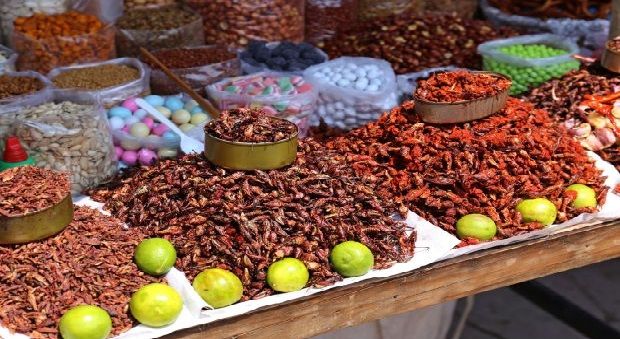For regular folk, surviving on an insect based diet in a SHTF situation is nothing more than a TV fantasy.
You know those shows, wilderness survival and all that, where the hero, let’s call him Beetle Juice, grabs a juicy grub, eats it and then asks for seconds.
However, bug eating is not at the top of any survivalist’s list of fun things to do, or at least not now, when you can buy a double cheeseburger with fries and ring onions at any fast food in like 5 minutes tops. However, in a survival situation, when food and water are scarce, one may find his taste in food changing radically.
The thing about eating bugs/insects is that it really makes perfect sense from a survival point of view. And in case you did not know, there are reputable publications advocating for people switching their diet to eating insects in a future brave new world.
Take this BBC piece for example, and if you think Bear Grylls is crazy, you have another thing coming.
Now, I am aware of the fact that most preppers imagine wilderness survival as a great outdoors adventure, that will end up with a ton of fishing and hunting stories to tell their friends and neighbors. However, in some situations, you may have to reconsider your attitude.
Earn Your Food Independence NOW
Unlike catching grubs and crickets, hunting deer is pretty difficult, especially if you don’t have the tools, the skills, or the energy. And that in the optimistic scenario, if there are any deer in the area. Okay, maybe I am exaggerating a bit, but I’m trying to make a point.
And the point is insects are everywhere, and they make for an awesome survival food in desperate SHTF scenarios. Also, you should be aware of the fact that bug eating is nothing new, nor gross.
For example, Romans were known for eating beetle larvae, while Greeks were practicing cicadas harvesting for food.
Even after the agricultural revolution, when food was plentiful for most of the people, insects still made their way into humans’ diets.
Currently, there are still millions of people who eat bugs on a regular basis, especially in Africa and Asia. Why, you asked?
The answer is pretty straight forward: those darn’ bugs must be delicious, and they’re definitely incredibly nutritious. When it comes to the nutritional value of insects, they stand their ground pretty well against meat. For example, caterpillars will provide you with more protein compared to the same quantity of beef.
The same goes for termites, that provide more calories per 100 grams than beef. Moth larvae are 63 percent protein, and again, most bugs are delicious when cooked, else people won’t eat them, am I right? It’s also important to emphasize how cost effective (in terms of energy) bug eating really is.
Besides having excellent nutritional value in terms of fat, protein and calories per 100 grams, bugs are fairly easy to find and to catch, and then to make a meal out of them. When you’re on the prowl hunting bugs, don’t forget to keep a container to store them within reach, alright?
Now, if you can get past the yuck factor with regard to eating bugs, the good news is that there are over 1400 species of edible insects in the US alone. There’s only a small caveat to that: while pretty much all insects can be eaten, you’ll have to follow a few rules, just to play it safe: avoid eating bugs that sting (you’ll probably learn about those the hard way), avoid bugs that smell badly, hairy insects and those with bright colors.
Also, you should not eat flies, as they’re known for spreading disease. However, there are exceptions to these rules, i.e. bees are considered edible and even tasty. Moreover, a number of cultures consider the hairy tarantulas to be delicacies.
The secret to eating those scary hairy spiders and other poisonous insects is that cooking the bug usually destroys the harmful poison inside, but then again, try to play it as safe as possible.
As a general rule of thumb, you should stick with eating “classic bugs”, like caterpillars, ants, beetles, bees, grubs, crickets, dragonflies, earthworms (worms generally speaking), termites, grasshoppers, leeches, junebugs, locusts, cicadas, and even cockroaches, whom, according to those brave folk that eat them, taste like chicken.
Now, provided you’re still with me, it would be recommendable to cook your bugs prior to ingesting their highly nutritious content. Else, you can always eat them raw, like a real man, or a vegan woman. The best part about eating bugs for survival purposes is that they’re all over the place.
If you want to find a tasty snack in the wilderness, just lift up an old log and you’ll most probably find some beetles under it, or some juicy grubs. Also, if you dig in the dirt, it’s almost sure you’ll find some insects to eat.
However, if you want to fill your belly, you’ll have to do better than that: check out this video and learn how to collect insects using pitfall traps, i.e. how to harvest insects for survival in an efficient matter. When it comes to harvesting your bug-meal, you should be aware of the fact that insects are just like fish in this regard: you can bait them with a mixture of yeast and sugar.
It’s also important to know that insects are easy to find under stones, fallen trees, near/under plants, or in the close vicinity of ponds and streams. Now, when it comes to eating bugs, the best way is to fry them, it’s the simplest method, the safest and also makes them taste the best. Or so I’ve heard.
You can fry your bugs in oil, butter, lard or whatever and you can season them with spices (salt, pepper) or aromatic herbs. Also, you can add insects to your stew, thus making for a true bug feast and boosting your meal’s nutritional value along with its appearance, and I am not kidding either: by adding crushed bugs to your stew, you’ll pretty much disguise their horrible appearance, thus making them more palatable.
Remember to remove the bugs’ wings and legs prior to cooking them.
Now, catching and eating bugs for survival in a hunter gatherer fashion is one thing, but let’s take this concept even further. Let’s say you’re preparing to live in a dystopic world, where the government turns rogue and steals all your guns, kills your cattle, nationalizes all private businesses and pulls the plug on the internet.
How can you provide for your family then? Think along the lines of Holodomor, China’s cultural revolution that killed millions via famines, North Korea and so forth and so on, i.e. every instance when a government killed its tax-farm-base by confiscating their means of survival.
The answer is: grow your own bugs, become a bug farmer, seriously. Insects can be grown easily (cricket farms ring a bell?), as they require small spaces and relatively few resources.
Most insects adapt quite well to farm-like environments , and they don’t require vast horizontal areas to live in and to thrive, like cattle does for example. To grow bugs, you’ll only need a batch of “prime breeders”, a plastic bin placed in a warm and well ventilated area, and some food, i.e. oats.
That’s all there is to it, if you want to grow your own bug chattel. To give you an example, one female cricket has a 4 months life span, during which it lays approximately 100 eggs.
Half of the eggs will hatch, you’ve guessed, female crickets, hence within the next few months, you’ll end up with 5000 crickets, give or take. Growing bugs is a very lucrative business.
I hope the article helped. If you’ve noticed any bugs inside (pun intended) or you have questions or comments, let us know what you think in the dedicated section below.









Chris | June 4, 2018
|
I would hate to eat something like that, BUT to survive….probably would.
The article does not give enough information though. Good start, but write more, how much to feed them, costs, what species are best for survival, macronutrient ratio.
Overall 2 out of 5.
Sam W | January 19, 2021
|
I’ve never given Chris Black more than 2 stars, and seldom that. But I give him a 3 on this one. Could have gotten another one if it wasn’t all hearsay.
Eileen Mynes | June 4, 2018
|
My favorite pet store grows crickets for exotic pets. They keep them in an aquarium with cardboard baffles. The crickets eat grass and other greenery. It seems to be quite easy. An army vet told me that crickets taste a little sweet, but grasshoppers taste like grass. My daughter ate steamed scorpions when she was a child, and loved it. I’m working up the courage to put an edible grub into my mouth, but as long as I have groceries, I make no promises. Here in South Texas, bugs multiply everywhere without any help at all.
Danny Lee | June 4, 2018
|
If you ”Bug In” (pun intended) you can raise bugs for yourself and your chickens. All it takes is a bit of prep work for ideal conditions for the bugs to multiply and an escape proof container for your side dish. Feed yourself, your chickens and go fishing. Also lure in a few birds to add to your diet.
Bill Michael | June 4, 2018
|
I read a book titled “4,000 days” which explained an Australian drug courier’s years in a Thailand prison. The Thai prisoners he was locked up with showed him how to survive by eating roaches they grew in a pit. They used leftover prison food to feed the roaches then they would grab a handful, crush them up and cook them (whenever possible), and eat them. This supplied enough essential protein that the prisoners survived. The other prisoners (mostly foreigners) who refused to eat the roaches died from malnutrition because the prison food was very bad lacking the necessary ingredients to preserve life. The Australian became good friends with the Thais and in the book explains that if it had not been for their kindness he would not have lived.
Armin | June 4, 2018
|
Even though we may be forced to eat insects in a survival situation the number one rule should be that we don’t eat bees. Bees already are an endangered species and they are essential for OUR survival. It would be much better for us to raise the bees to give us honey and to let them do their job to pollinate the flowers. It’s much more effective for us to raise bees for honey. Anyone suggesting we eat bees as a survival food is obviously misguided or hates bees or has a reaction to a bee sting. I think it was Einstein that said if there were no more bees the human race had about 4 years. Speaking for myself I would rather eat the delicious honey that bees produce than eat the bees themselves. I think Chris should ask himself why he included bees in the list of edible insects without taking into account the many more benefits that live bees can give us as opposed to eating these little wonders of creation. To paraphrase, the enemy of my friend is my enemy.
Jon | June 4, 2018
|
Actually the honey bee is an invasive specie and isnt necessary for the new world.We have our own pollinators like sweat bees and other native insects. that honey bee things that has spread around is aactually a lie
Armin | June 5, 2018
|
@Jon I disagree. You may be confusing Apis Mellifera, which is the most common domesticated species, with the so-called killer bees which is an Africanized species and the latter are obviously invasive. And there ARE many crops that depend on the honey bee for pollination. I see nothing that says anything about a “sweat” bee. I don’t think bees sweat anyways. LOL! Chris contradicts himself in the article. In one part he lists bees as something to eat. In another part he says that you should be very careful eating anything that stings and obviously bees sting, Somewhere I’ve read that honey bee venom is more powerful than that of the cobra but obviously the amount injected is miniscule compared to that of the snake. Still hurts like a son of a gun though.
Sam | October 30, 2018
|
“Common” Honey Bees originated from africa, and spread up to europe and got spread around from there.
The Killer Bee may also be from Africa but he is not confusing the two.
The only reason you have honey bees in america is because they were taken there to be FARMED FOR HONEY!!!
There are hundreds of bee species world wide that do pollinate but DO NOT PRODUCE HONEY.
The fact that those crops are dependent on honey bees is because it is profitable to have a hive you can profit from.
Farmers keeping bee hives in their fields are purely to get the MAXIMUM harvest with MINIMUM COST and if you can earn off your free pollinators, well why not?
Deborah Bortot | October 30, 2018
|
I do not know of any bee called a sweat bee. When we were kids, there was an insect we called a sweat bee, but it is not a bee. The sweat bee is actually a hover fly. We called them sweat bees because they looked a lot like a honey bee and they are attracted to the sweaty parts of the body. Hope this is helpful.
Armin | June 4, 2018
|
Just to be clear and so that people don’t think the Holodomor WAS the Chinese cultural revolution, the Holodomor was a man-made famine in Soviet Ukraine in 1932 and 1933 that killed millions of Ukrainians that was part of the wider Soviet famine of 1932–33, which affected the major grain-producing areas of the country. This was genocide committed by Joseph Stalin’s government.
UNCLE Debbie | June 4, 2018
|
I have eaten ants before and meal worms. Meal worms taste nasty if you chew them so I just swallowed them whole. They were even still alive. I watched a show on Netflix about the future of eating bugs. They showed how to cook grubs and all kinds of other insects and worms. Oh by the way, don’t chew earthworms either. They are easier to eat if you just swallow them.
John Brown | June 5, 2018
|
DO NOT EAT LEECHES! These are not insects. Tiny parts can and do replicate into whole leeches! Do you want then in or on you?
Chris | June 5, 2018
|
Thanks for the info. Did not know THAT !
Philippe Boeing | June 5, 2018
|
Yea, well in desperate times where there is no option, maybe. But I would much rather grow insects like black soldier flies, earthworms etc., to feed something more common to human diet such as chickens, pigs or fish.
Armin | June 5, 2018
|
I’m with you, Philippe. That makes much more sense to me if we have the foresight and time and money to acquire that piece of property where we can have chickens, pigs and fish. I would have to be very desperate to even think about eating insects. I’ve never been THAT hungry so I don’t know what I would do in that type of situation. I’m not particularly religious but I know the Bible prohibits eating insects and I wonder if it does so for a reason.
Diane McKeever DDS | August 25, 2018
|
NB If you are allergic (or hypersensitive to shellfish) do not consume insects with chitinous shells either. You may have the same violent reaction as the proteins are in the same family.
Pingback:Beyond Distaste: Bug Eating For Survival – Part 2 | Survivopedia | December 27, 2018
|